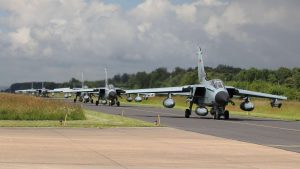Japanese Defense Minister Kihara Minoru announced at a press conference on June 25 that Japan’s Air Self-Defense Force (ASDF) will conduct a series of joint drills with the air forces of Germany, France, and Spain in Japan in July.
This is the first time that aircraft from the three European countries’ air forces will be deployed to Japan at the same time. This also marks the first time that the ASDF will conduct joint training with the Spanish Air Force in Japan and the second time with the German and French air forces.
“The successive visits to the Indo-Pacific region by the military forces of these countries are evidence of their will and ability to engage with the Indo-Pacific region,” Kihara said, pointing out that the Japan Maritime Self-Defense Force has also already conducted joint training with the navies of Turkey, the Netherlands, and India in June in waters surrounding Japan.
“Joint training with the military forces of other countries around Japan not only improves the tactical skills of the Self-Defense Forces, but also deepens cooperation with other countries toward the realization of a ‘Free and Open Indo-Pacific,” Kihara added.
The upcoming joint drills with three European countries are part of a joint exercise called Pacific Skies 24, in which they will deploy fighter jets and other aircraft to the Indo-Pacific region, including Alaska and Hawaii in the United States as well as Australia, for about two months from mid-June to mid-August.
“By participating in Pacific Skies 24, we as Europeans are showing presence in a part of the world that is of great importance to all of us. We will deploy to the Indo-Pacific region together with Spain and France and take part in five different exercises,” the chief of the German Air Force, Lieutenant General Ingo Gerhartz said in a statement on Bundeswehr’s website.
Specifically, the ASDF said the joint training between the ASDF, the German Air Force, and the Spanish Air and Space Force will take place in the airspace around Chitose Air Base in Hokkaido from July 19 to 20. Four F-15 fighter jets from Japan; eight Eurofighter fighter jets, three A400M transport aircraft, four A330MRTT aerial refueling aircraft, and one A321 transport aircraft from Germany; and four Eurofighter fighter jets and two A400M transport aircraft from Spain will participate. About 180 personnel from Germany and about 150 personnel from Spain will take part in and conduct various tactical training exercises with the ASDF.
Separately, Japan and Germany are scheduled to conduct joint training in the airspace around the Chitose Air Base from July 22 to 25. Four F-15 fighter jets from the ASDF as well as three Eurofighter fighter jets, two A400M transport aircraft, and one A321 transport plane from the German Air Force will participate. About 80 members of the German Air Force will take part in.
On top of this, the ASDF and the French Air and Space Force will conduct joint training in the airspace around the ASDF’s Hyakuri Air Base in Ibaraki Prefecture in the Kanto region from July 19 to 20. The ASDF will be represented by two F-2 fighter jets, while the French Air and Space Force will send four Rafale fighter jets, three A400M transport aircraft, and three A330MRTT aerial refueling aircraft, with its 260 personnel.
Japan’s Ministry of Defense stressed that these joint exercises are not targeted at any particular country or region, but the drills, conducted under the slogan “Free and Open Indo-Pacific,” are apparently a sign of Tokyo’s intention to use them as a deterrent to counter a more assertive China.

































